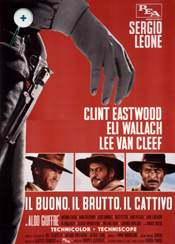 |
 |
|
|
|
(My Name Is Nobody)
Directed by Tonino Valerii and produced by
Sergio Leone, 1973
Story by: Fulvio Morsella, Ernesto Gastaldi, from
an idea by Sergio Leone
Script by: Ernesto Gastaldi
At the end of the 19th century, veteran American
gunfighter Jack Beauregard plans to retire to Europe,
but an energetic drifter with a gun - called Nobody -
will not let them. Nobody hero-worships Beauregard and
works hard to set up a historic confirmation between him
and the notorious Wild Bunch. Following this, it will be
Nobody's turn to become famous - to become Somebody -
while the gunfighter can at last retire. My Name is
Nobody is, at heart, about the relationship between
the American and the Italian Western.
 |
|
 Per un pugno di dollari
Per un pugno di dollari
(A Fistful of Dollars)
Directed by Sergio Leone, 1964
Story by Sergio Leone after Akira Kurosawa; uncredited.
Script by: No credit given in the film Duccio Tessari,
Victor A. Catena, Fernando Di Leo, Sergio Leone and
others, from the screenplay Yojimbo by Ryuzo
Kikushima and Akira Kurosawa; no credit given in film
A stranger in a poncho rides into the small town of San
Miguel, just south of the American-Mexican border. He
soon learns that the town is being run by two rival
gangs - the American Baxters and the Mexican Rojos.
Selling his skills first to one gang, then to the other,
he manages to profit from both, eventually riding out of
San Miguel with much more than a fistful of dollars - as
a new kind of Western hero.
Per un pugno di dollari (A Fistful of Dollars),
directed by Bob Robertson (Sergio Leone), 1964.
Italian, 55 x 39 in. Designed by Sandro Simeoni. The
Frayling Archive SL001. Click poster image to
enlarge.

Per qualche dollaro in più (For a Few Dollars
More), 1965. Italian, 19 x 27 in., fotobusta.
The Frayling Archive RSL929 Click image to
enlarge.
Per qualche dollaro in più
(For a Few Dollars More)
Directed by Sergio Leone, 1965
Story by: Sergio Leone, Fulvio Morsella
Script by: Luciano Vincenzoni, Sergio Leone
Two American bounty hunters are working around the
Mexican border, after the Civil War. They form an uneasy
partnership to capture - dead or alive - the
psychopathic bandit El Indio, plus his gang, and claim
the substantial reward. The older bounty hunter is out
for revenge; the younger one just wants the dollars.
Following the final duel, El Indio is killed and each of
the hunters gets what he wants.

Il buono, il brutto, il cattivo (The Good, the
Bad and the Ugly), 1966. Italian, 78 x 55 in.,
first Italian edition for the year 1966. The
Frayling Archive SL109. Click image to enlarge.
Il buono, il brutto, il cattivo
(The Good, the Bad, and the Ugly)
Directed by Sergio Leone, 1966
Story by: Luciano Vincenzoni, Sergio Leone
Script by: Age and Scarpelli (Agenore Incrocci and Furio
Scarpelli), Luciano Vincenzoni, Sergio Leone and (uncredited)
Sergio Donati
It is 1861-2 during the Civil War, and the three main
characters - a "good" bounty hunter, a
"bad" hired gunman and an "ugly"
Mexican outlaw - organize various scams, while trying to
avoid the wartime destruction that is happening all
around them. They eventually meet in a huge cemetery,
where $200,000 in Confederate army gold has been buried.
The "good" rides away with half the loot, the
"bad" is killed, while the "ugly"
ends up with a rope around his neck and the other half
of the loot. The labels good, bad,and ugly have,
throughout the story, been questioned. The good guy can
do bad things; the bad guy can do good things; the ugly
guy's personality is the most attractive in the film.
C' era una volta il West
(Once Upon a Time in the West)
Directed by Sergio Leone, 1968
Story by: Dario Argento, Bernardo Bertulucci, Sergio
Leone
Script by: Sergio Donati, Sergio Leone
Once Upon a Time in the West, the fairytale of
the Hollywood Western - represented by its best-known
character types and story motifs - collides with the
historical reality of the railroad boom. As the railroad
relentlessly pushes its way across the desert, the main
characters cross each other's paths, settle old scores,
meet their destinies, and in the end lay the foundations
of modern America ("Once upon a time there was a
West"). In the process, they leave the traditional
Western stories behind ("Once upon a time there was
a Western").
Once Upon a Time in the West (C¹era una volta il
West), 1968. Australian 30 x 13 in. The Frayling
Archive RSL137. Click image to enlarge.

Giù la testa (Duck, You Sucker), 45 rpm recording
cover. Courtesy of the Frayling Archive. Click
image to enlarge.
Giù la testa
(Duck, You Sucker)
Directed by Sergio Leone, 1971
Story by: Sergio Leone, Sergio Donati
Script by: Luciano Vincenzoni, Sergio Leone, Sergio
Donati
In 1913, during the Mexican Revolution, a peasant bandit
called Juan teams up with a cynical Irish revolutionary
called Sean. Against a backdrop of historical transition
- from horses to motorcycles, Winchesters to machine
guns, stagecoaches to armored cars - Sean is determined
to turn Juan into a "great, glorious hero of the
revolution." Juan is not so sure. The cat-and-mouse
relationship between the two men leads to revolutionary
success . . . and personal tragedy. The message is
"keep your head down."
|
|
|